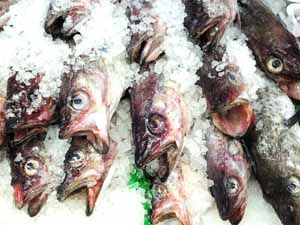The grouper fish are teleosts, and they typically have a stout body and a large mouth. They are often found around coral reefs, and rocky ledges. And they are also found in other structures where they can hide and ambush prey. They are typically bottom-dwelling fish. And they prefer water depths ranging from shallow waters to deeper offshore areas.
Groupers are actually fish of a number of genera in the subfamily Epinephelinae of the family Serranidae, in the order Perciformes. Not all serranids are called “groupers”, and the family also includes the sea basses. Actually, the common name “grouper” is usually given to fish in one of two large genera: Epinephelus and Mycteroperca. However, read some more information about this popular fish species below.
What is Grouper fish?
The Grouper is a type of fish belonging to the family Serranidae. And this family includes around 160 species of fish. Grouper fish are typically found in warm, tropical, and subtropical waters (especially in the Atlantic Ocean, Mediterranean Sea, and Indo-Pacific regions).

Grouper fish in Spanish
Grouper fish is known in many different names in many different areas around the world. In Spanish, grouper fish is typically referred to as “mero”.
Characteristics
Like many other fish species, the Grouper fish also have several distinctive physical characteristics. And these physical characteristics set them apart from other fish species. The Groupers are actually known for their thick, muscular bodies, and they typically have a compressed, oval shape.
The Groupers typically have dull or mottled colors, and their coloration can rage from shades of brown, green, yellow, gray, and even red. They often have dark spots or blotches on their body. Their mouth is large and the teeth are strong, and sharp.
Size and weight
Exact size of the Grouper fish depends on numerous factors and can vary from place to place. They typically reach up to 8 feet body length, and their average body length is around or up to 360 kg.
Diet
The Groupers are carnivorous predator fish, and they are opportunistic predators. They will eat a variety of prey depending on the environment and availability. They typically feed on smaller fish, crustaceans, and other marine invertebrates.
Reproduction
Reproduction or breeding cycle of Grouper fish is very interesting and pretty different than most other common fish species. They exhibit protogynous hermaphroditism. That means, they are born as females and can change sex to become males later in life. This process helps to ensure there are enough males to continue the reproduction process.
Like other fish species, the Grouper fish also like to spawn in big groups. They typically spawn in coral reefs or deep waters. They tend to spawn around the full moon, and this helps them to release their eggs and sperm at the same time.
During spawning, the female Groupers release millions of eggs into the water. And then the males release sperm over the eggs, and the fertilization process is done in the water. After successful fertilization, the eggs float and eventually hatch into tiny fish called larvae. Then these larvae drift in the ocean until they grow big enough to settle down on the ocean floor.
Lifespan
Average lifespan of the Grouper fish depends on the species. Average lifespan of the smaller Grouper species is typically between 10 to 15 years. While the large sized grouper fish live longer with an average lifespan of around or up to 50 years.

Uses
The Grouper fish is mainly used as food. It is a commercially important and very popular seafood, and it can be used as food in many different ways.
Cooking and recipes
You can enjoy the Grouper fish in many different ways. There are numerous cooking ways and recipes available to try. Some most common and popular cooking ways are grilling, baking, fish tacos or sandwiches, and using Grouper fillets in soups, stews, and curries is also popular.
Taste
The Grouper fish is very tasty. That’s why it is very common and popular in many dishes. It has a mild, sweet flavor with a slightly firm, flaky texture. Its meat is white and moist, and it is suitable for cooking in many different ways.
Nutrition and health benefits
The Grouper fish is highly nutritious and it provides several health benefits. A 100 grams serving provides:
- Calories: 120–130 kcal
- Protein: 22–24 grams
- Fat: 2–3 grams
- Saturated fat: 0.5–1 gram
- Omega-3 fatty acids: 0.2–0.5 grams (varies by species and diet)
- Cholesterol: 50–60 milligrams
- Sodium: 60–80 milligrams
- Potassium: 400–500 milligrams
- Vitamin D: 1–2 micrograms (varies)
- Vitamin B12: 1–2 micrograms
- Calcium: 10–15 milligrams
- Iron: 0.5 milligram
As you can see, it is rich in many nutrients. So, consuming Grouper fish will provide you several health benefits. Grouper is actually a great source of lean protein, which is essential for muscle growth and repair. It is very low in fat and zero in carbohydrates, and it is a very healthy choice for people looking to reduce fat intake. It is a good source of omega-3 fatty acids and also rich in some essential vitamins and minerals.
Price
It is very tough for us to tell the exact price of the Grouper fish. Because exact price depends on numerous factors and can vary from place to place. Frozen Grouper typically cost around $10 to $20 per pound. And price of the fresh fish is much higher, ranging from $15 to $30 per pound.
Frequently asked questions (FAQs)
People often ask some questions regarding this fish species. Here we are trying to list the most common and frequently asked questions about the Grouper fish. Hope these answers will help you. Don’t hesitate to ask if you have more questions.
Can you eat Grouper fish?
Yes, sure! Grouper is actually a very popular seafood choice in many countries around the world. Grouper has a mild, firm, and white flesh. You can enjoy this fish in many different ways including grilling, baking, frying, or broiling.
How to cook Grouper fish?
Cooking Grouper fish is relatively easy and simple. Actually, you can cook this fish in many different ways by following many different recipes. However, some most common and popular cooking methods are grilling, baking, frying, broiling or using in soups or stews.
Is Grouper fish healthy?
Yes, definitely it is healthy! It is a low-fat fish and very high in protein. It is also rich in omega-3 fatty acids and some essential vitamins and minerals.
What does Grouper fish taste like?
Grouper has a mild, slightly sweet flavor with a firm, flaky texture. Its taste is often described as delicate and light.
How big can a grouper fish get?
Depends on the species, and age of the fish. The Goliath Grouper is the biggest, and it can reach up to 8 feet long and weight over 360 kg. While some other species such as the Black Grouper can reach a length of 4 feet and can weight around or up to 100 pounds.
Is Grouper fish kosher?
No, Grouper fish is not kosher. These fish have fins, but do not have scales.
Does Grouper fish have scales?
No, Groupers do not have scales.






